---恢复内容开始---
分布式项目架构
根据业务需求进行拆分成N个子系统,多个子系统相互协作才能完成业务流程子系统之间通讯使用RPC远程通讯技术。
优点:
1.把模块拆分,使用接口通信,降低模块之间的耦合度。
2.把项目拆分成若干个子项目,不同的团队负责不同的子项目。
3.增加功能时只需要再增加一个子项目,调用其它系统的接口就可以。
4.可以灵活的进行分布式部署。
有优点就有缺点,缺点如下:
1.系统之间交互需要使用远程通信,接口开发增加工作量。
2.各个模块有一些通用的业务逻辑无法共用。
为了解决上面分布式架构的缺点,我们引入了soa架构,SOA:Service Oriented Architecture面向服务的架构。也就是把工程拆分成服务层、表现层两个工程。服务层中包含业务逻辑,只需要对外提供服务即可。表现层只需要处理和页面的交互,业务逻辑都是调用服务层的服务来实现。
rpc远程调用框架
几种比较典型的RPC的实现和调用框架。
(1)RMI实现,利用java.rmi包实现,基于Java远程方法协议(Java Remote Method Protocol)
和java的原生序列化。
(2)Hessian,是一个轻量级的remoting onhttp工具,使用简单的方法提供了RMI的功能。 基于HTTP协议,采用二进制编解码。
(3)thrift是一种可伸缩的跨语言服务的软件框架。thrift允许你定义一个描述文件,描述数据类型和服务接口。依据该文件,编译器方便地生成RPC客户端和服务器通信代码。
(4)SpringCloud 为开发人员提供了快速构建分布式系统的一些工具,包括配置管理、服务发现、断路器、路由、微代理、事件总线、全局锁、决策竞选、分布式会话等等。
(4) Dubbo是阿里巴巴公司开源的一个高性能优秀的服务框架,使得应用可通过高性能的 RPC 实现服务的输出和输入功能,可以和 Spring框架无缝集成。
1.服务的注册与发现(Eureka )(注册中心)

Eureka环境搭建:
1.pom文件如下
<parent>
<groupId>org.springframework.boot</groupId>
<artifactId>spring-boot-starter-parent</artifactId>
<version>1.5.2.RELEASE</version>
<relativePath /> <!-- lookup parent from repository -->
</parent>
<properties>
<project.build.sourceEncoding>UTF-8</project.build.sourceEncoding>
<project.reporting.outputEncoding>UTF-8</project.reporting.outputEncoding>
<java.version>1.8</java.version>
</properties>
<dependencies>
<!--eureka server -->
<dependency>
<groupId>org.springframework.cloud</groupId>
<artifactId>spring-cloud-starter-eureka-server</artifactId>
</dependency>
<!-- spring boot test -->
<dependency>
<groupId>org.springframework.boot</groupId>
<artifactId>spring-boot-starter-test</artifactId>
<scope>test</scope>
</dependency>
</dependencies>
<dependencyManagement>
<dependencies>
<dependency>
<groupId>org.springframework.cloud</groupId>
<artifactId>spring-cloud-dependencies</artifactId>
<version>Dalston.RC1</version>
<type>pom</type>
<scope>import</scope>
</dependency>
</dependencies>
</dependencyManagement>
<build>
<plugins>
<plugin>
<groupId>org.springframework.boot</groupId>
<artifactId>spring-boot-maven-plugin</artifactId>
</plugin>
</plugins>
</build>
<repositories>
<repository>
<id>spring-milestones</id>
<name>Spring Milestones</name>
<url>https://repo.spring.io/milestone</url>
<snapshots>
<enabled>false</enabled>
</snapshots>
</repository>
</repositories>
2.配置application.yml
port: 8888
eureka:
instance:
hostname: localhost
client:
registerWithEureka: false
fetchRegistry: false
serviceUrl:
defaultZone: http://${eureka.instance.hostname}:${server.port}/eureka/
3.配置Springboot的启动文件
package com.nswi;
import org.springframework.boot.SpringApplication;
import org.springframework.boot.autoconfigure.SpringBootApplication;
import org.springframework.cloud.netflix.eureka.server.EnableEurekaServer;
/**
*
*@author jianghaojie
*Date:2019年3月14日
*
*/
@SpringBootApplication
@EnableEurekaServer
public class App {
public static void main(String[] args) {
SpringApplication.run(App.class, args);
}
}
4.打开eureka可以看见生产者service-menmber与service-order都同时注入到eureka中

查看service-menber

查看service-order

生产者与消费者将IP和端口号注入eureka,消费者在eureka中拿到生产者的IP与端口号,在通过httpclient请求对生产者进行调用

---恢复内容结束---